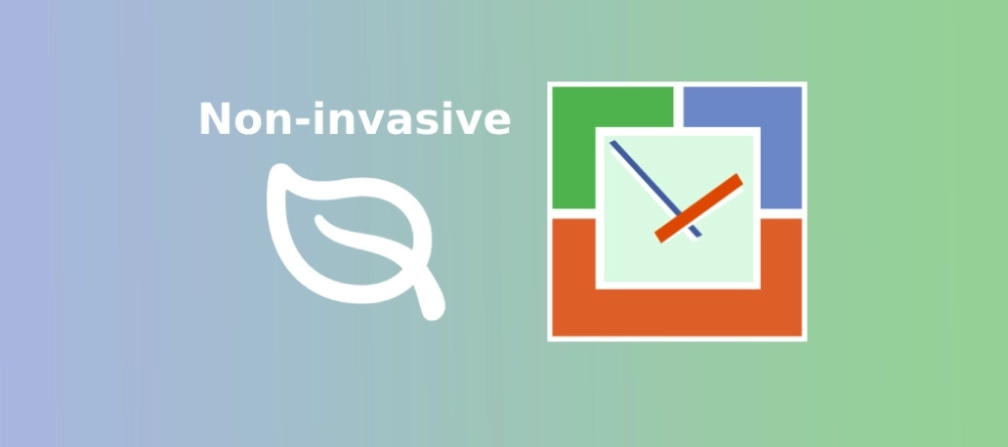What to look for in computer monitoring software for employees?
The worst time tracking software features Screenshots, video/audio monitoring Keystrokes monitoring Hidden installation Hidden monitoring data Non-law-compliant software Chaotic report system No monitoring data analyses The best time tracking software features Productivity monitoring Simple user interface Compliance with law regulations Attendance management and monitoring Remote and in-office productivity comparison Goals setting Internet usage statistic Leaderboard Non-invasive approach How to choose the best employee monitoring software?We are WorkTime, a software company with over 20 years of industry experience, specializing in non-invasive employee monitoring and productivity tracking.
The worst time tracking software features
While all monitoring software serves the primary function of employee surveillance, not every solution is crafted with equal consideration for employee well-being. Some features may have unexpected drawbacks. From privacy concerns to inefficiencies in data analysis, understanding these drawbacks will help you to create a positive and productive work environment while maintaining employee trust and privacy.Screenshots, video/audio monitoring
Software that captures screenshots, video, and audio varies in functionality, with some platforms taking random screenshots or triggering captures when specific programs are accessed. However, implementing intrusive monitoring practices can lead to severe consequences. It is potentially illegal and will damage trust between you as an employer and your team, leading to increased stress and dissatisfaction. Additionally, there's a significant risk of data breaches, as screenshots can capture sensitive information. Even if employees perform well under surveillance, the demonstrated lack of trust can hinder productivity and motivation, potentially leading employees to seek another workplace. Therefore, you should prioritize trust, privacy, and mutual respect in the workplace to maintain a positive and productive environment.Even if employees perform well under surveillance, the demonstrated lack of trust can hinder productivity and motivation, potentially leading employees to seek another workplace.
Keystrokes monitoring
Certain software also offers keystroke monitoring, a feature that records every keystroke entered on a computer and saves the data into a text file for later review. Some tools even capture information from the copy-cut-paste clipboard. Keystroke logging sometimes even involves tracking and recording keystrokes without the user's consent or awareness. This approach shares similarities with screenshots and video tracking in terms of privacy concerns, ultimately damaging trust. While some argue that keystroke monitoring could help identify instances of data theft, the reality is that sifting through vast amounts of recorded keystrokes is inefficient and time-consuming. As a result, this practice is more likely to cause harm than provide you with any meaningful benefit.While some argue that keystroke monitoring could help identify instances of data theft, the reality is that sifting through vast amounts of recorded keystrokes is inefficient and time-consuming.
Hidden installation
Installing software without the employee's knowledge may seem appealing. It could provide an opportunity to catch employees off guard if they engage in non-work-related activities during working hours. However, there are significant drawbacks to this approach. Firstly, it's illegal in many countries. Secondly, even if you uncover problems, you may face challenges addressing them or terminating the employee without revealing your monitoring tactics. This could lead to questions and potential legal trouble for you as an employer.Hidden monitoring data
That approach seems counterproductive. If employees are aware of monitoring and its results, they have the opportunity to improve their performance. Otherwise, what's the point? This feature is similar to the previous one, but it involves withholding the results and data from monitoring employees. All reports and information are solely available to you as the employer. While there are no clear negative consequences of this action, there are also no clear benefits. If employees can access the monitoring data, they have the chance to identify and address any issues independently, improve self-discipline, and solve the problem by themselves. This reduces the need for micromanagement on your part as an employer. By restricting access to the data, you deprive yourself of these potential benefits.If employees can access the monitoring data, they have the chance to identify and address any issues independently, improve self-discipline, and solve the problem by themselves.
Non-law-compliant software
When it comes to saving and storing monitoring data on your employees, there are two general approaches: cloud-based and on-premises. The first involves data leaving your company's premises, while the latter ensures that data can only be accessed by you. If the software you choose complies with the data privacy regulations in your country, both options are secure. However, if they do not comply, problems arise immediately. Screenshots and video recordings could potentially leak, resulting in the exposure of sensitive information about your company and employees and potentially dire consequences.Chaotic report system
Choose software that organizes data into clear, structured reports. This way, you can efficiently track active time, attendance, and workflow without getting lost in piles of information. Without organized reporting, you'll spend too much time manually sifting through data and analyzing it yourself. This can lead to micromanagement and distract you from your main tasks. By using software with structured reporting, you can streamline the monitoring process and better focus on your tasks.By using software with structured reporting, you can streamline the monitoring process and better focus on your tasks.
No monitoring data analyses
Expanding on the previous point, focusing solely on an employee's active time and idle time and assuming it correlates directly with productivity won't provide you with accurate insights. Productivity is a multifaceted concept that requires a deeper analysis beyond mere active time, login time, or internet usage. Opt for software that not only monitors but also analyzes employee activity data. Relying solely on monitoring can stifle employee creativity and hinder the quality of their work. Instead, consider solutions that offer comprehensive analysis to gain a more nuanced understanding of productivity and employee work.The best time tracking software features
In today's rapidly evolving workplace landscape, the adoption of employee monitoring software requires more attention to employee well-being. Some features may provide significant advantages of non-invasive software that are not immediately apparent. From comprehensive productivity tracking to simplified user interfaces and compliance with legal regulations, these features contribute to a positive work environment and help you reach your work goals.Productivity monitoring
To understand how your employees work, choose software like WorkTime that analyzes monitoring data effectively. For example, combine it in a general productivity report. WorkTime provides a comprehensive productivity report that categorizes all active time as either productive or unproductive, based on the apps and websites used. What's even better is the flexibility to customize these categories to fit your preferences, adjusting them for different departments. This customization ensures that your productivity analysis accurately reflects your teamwork pattern.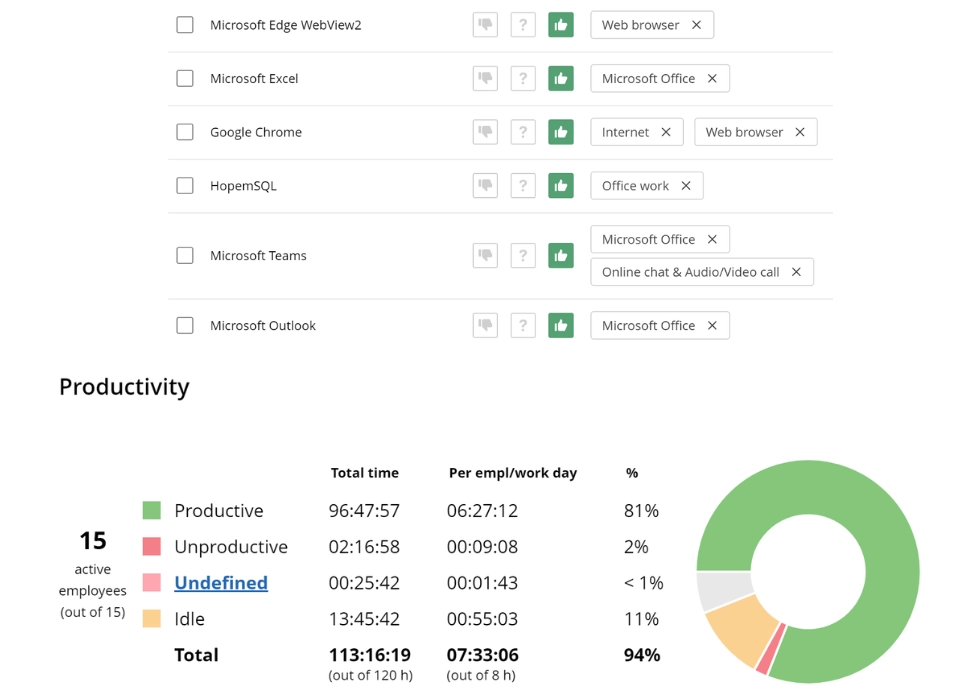
To understand how your employees work, choose software like WorkTime that analyzes monitoring data effectively.
Simple user interface
For improved monitoring results, opt for software with a simple and clear interface and reporting system. This way, you won't waste time decoding complex monitoring data. With WorkTime, you get access to over 50 reports, all neatly categorized and designed for easy understanding. This not only enhances your understanding of employee monitoring data but also saves you valuable time. It will allow you to focus on analyzing the results and taking action when necessary.Compliance with law regulations
One aspect you might not immediately consider when implementing employee monitoring is where all the monitoring data will be stored. There are two primary options: cloud-based and on-premises storage. Choose software, like WorkTime, that complies with data privacy regulations to ensure security, regardless of the storage type you select. This will prevent any concerns about data leakage.WorkTime, for instance, is fully compliant with HIPAA, GDPR, and numerous local laws. This compliance ensures that your monitoring activities are conducted within legal boundaries, safeguarding sensitive information about your company and employees from potential breaches. By adhering to regulatory requirements, WorkTime mitigates the risk of data leakage and upholds the security and confidentiality of your monitoring data.Choose software, like WorkTime, that complies with data privacy regulations to ensure security, regardless of the storage type you select.
Attendance management and monitoring
Among the useful features is attendance monitoring. What makes it particularly valuable is its comprehensive functionality. Not only can you track an employee's presence, but you can also customize settings to suit your needs. With WorkTime, this includes setting working hours and monitoring adherence to these schedules. You also can access detailed statistics on punctuality, allowing you to identify any concerning patterns of lateness. With WorkTime, managing your remote team's attendance is effortless, ensuring employees are consistently on time for work.Remote and in-office productivity comparison
Unsure if your employees maintain the same level of performance when working from home? With WorkTime try the feature that not only monitors remote employees but also allows for comparison of their performance in hybrid settings. Determine whether they excel more at home or in the office. Perhaps they show increased productivity at home or perform better during holidays in the office. Determine when distractions are minimized for them. WorkTime provides access to these and other features, particularly useful for comparing employee performance across various settings.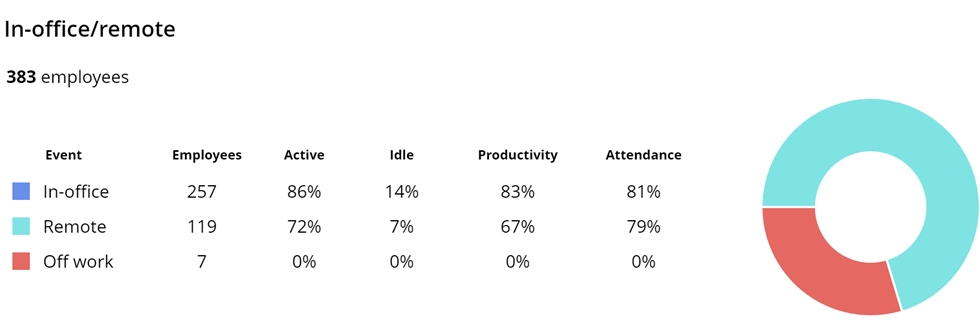
With WorkTime try the feature that not only monitors remote employees but also allows for comparison of their performance in hybrid settings.
Goals setting
Communicate clear expectations to your employees regarding their performance goals. If you've opted for monitoring, it's likely because you feel employees are not meeting your productivity standards. Instead of solely tracking their active time, outline your expectations to them. With WorkTime you can set specific goals in terms of the number of active hours they should achieve weekly or the level of consistency required in their attendance. This feature minimizes the time you would otherwise spend manually reviewing reports to ensure they meet your work requirements.
With WorkTime you can set specific goals in terms of the number of active hours they should achieve weekly or the level of consistency required in their attendance.
Internet usage statistic
One of the most valuable features for tracking employee productivity is monitoring internet activity to ensure they aren't getting too distracted with activities like browsing, gaming, or online shopping. Internet monitoring with WorkTime allows you to track employees' overall internet time and the specific websites they visit. Since modern work often requires internet use, you need to accurately categorize internet time as productive or unproductive.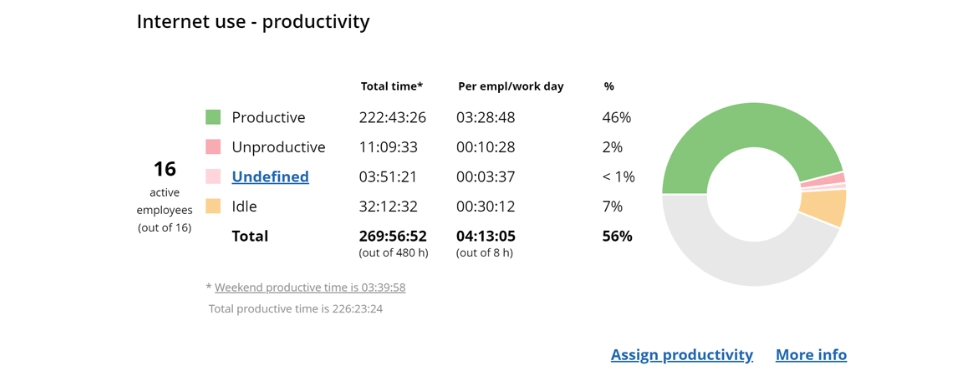
With WorkTime, you can customize which websites are considered useful or not, providing you with accurate statistics on time spent on unrelated work activities. This customizable feature can be adjusted for specific departments.Internet monitoring with WorkTime allows you to track employees’ overall internet time and the specific websites they visit.
Leaderboard
To foster a positive relationship with your employees, highlight the beneficial aspects of monitoring. This will help employees to understand that it's not just about discipline but also about recognizing their contributions. The WorkTime leaderboard feature will make employees feel that their hard work is acknowledged, which naturally boosts their motivation and improves performance. This feature compiles report data to create a list of top-performing employees, allowing you to showcase their valuable contributions and show appreciation for their efforts.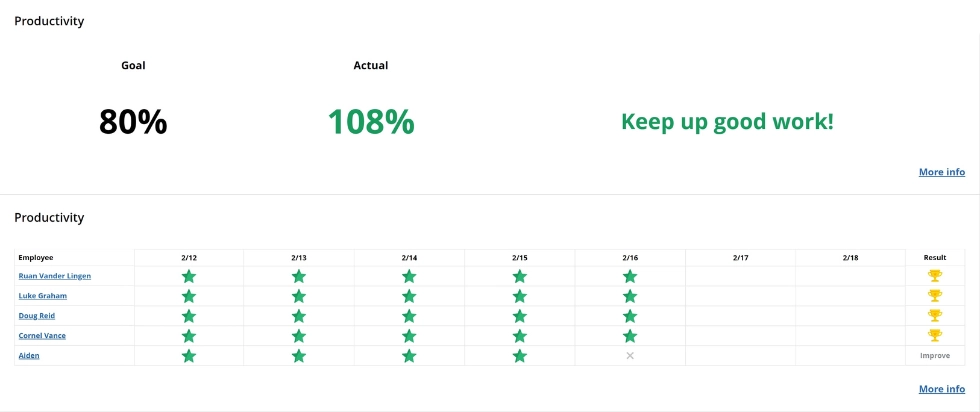
The WorkTime leaderboard feature will make employees feel that their hard work is acknowledged, which naturally boosts their motivation and improves performance.
Non-invasive approach
In 2024, there's a noticeable shift towards a more holistic approach to productivity, placing greater importance on employee well-being. This is reflected in the features and methods being adopted. It's no longer acceptable for monitoring software to invade employee privacy by recording everything or installing software without their knowledge and consent.Instead, monitoring tools will increasingly incorporate features aimed at tracking and analyzing stress levels, workload, and overall job satisfaction. This data will enable employers to cultivate environments that prioritize mental health and work-life balance. With WorkTime, you can now implement non-invasive monitoring that provides insights into employee productivity and distractions without adding unnecessary stress.It's no longer acceptable for monitoring software to invade employee privacy by recording everything or installing software without their knowledge and consent.









